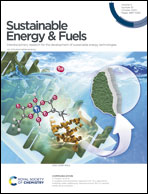A multi-shelled CeO2/Co@N-doped hollow carbon microsphere as a trifunctional electrocatalyst for a rechargeable zinc–air battery and overall water splitting†
Abstract
Herein, we demonstrate a self-template method to construct an efficient and stable trifunctional catalyst, where CeO2/Co nanoparticles are evenly embedded in a nitrogen-doped carbon hollow microsphere with a multi-shell nanostructure (CeO2/Co@NCH). As an electrocatalyst for the oxygen reduction reaction (ORR), it exhibits an onset potential of 0.852 V and a half-wave potential of 0.778 V versus RHE, as well as superior durability and methanol tolerance. Meanwhile, it illustrates a high activity towards the oxygen evolution reaction (OER) in 0.1 M KOH electrolyte, which only requires an overpotential of 470 mV to drive the current density of 10 mA cm−2. Moreover, the rechargeable zinc–air battery using the CeO2/Co@NCH as the air cathode electrocatalyst indicates a high round-trip efficiency with a low overpotential after 170 hours. As for overall water splitting in alkaline solution, it needs only 1.74 V to afford a 10 mA cm−2 current density with excellent long-term stability. Furthermore, a water splitting cell is integrated with rechargeable zinc–air batteries by taking advantage of the OER/ORR and OER/hydrogen evolution reaction (HER) performance of the sample, and the results present its potential as a good candidate for applications in renewable and sustainable energy conversion.



 Please wait while we load your content...
Please wait while we load your content...